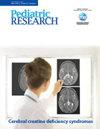Phlebotomy-induced anemia reduces oxygen-induced retinopathy severity and dampens retinal developmental transcriptomic pathways in rats
IF 3.1
3区 医学
Q1 PEDIATRICS
引用次数: 0
Abstract
Phlebotomy-induced-anemia (PIA), which induces tissue hypoxia and angiogenesis, occurs universally among infants at risk for severe retinopathy of prematurity (ROP). We hypothesized that PIA exacerbates pathologic retinal neovascularization in ROP. We induced PIA to a hematocrit of 18% among rats undergoing the established 50/10 oxygen-induced retinopathy (OIR) model. Rats were euthanized at P15 and P20, during the avascular and neovascular phases of OIR, respectively. Retinal vascular morphometry, cytokine/chemokine concentrations, transcriptomes, and mRNA expression of angiogenic and iron-deficiency markers were compared to non-PIA controls. In OIR, PIA decreased percent avascular area at P15 by 35%, percent neovascular area at P20 by 42%, and select pro-inflammatory cytokine/chemokine concentrations at both time points. At P20, PIA increased mRNA expression of angiopoietin 2/ vascular endothelial growth factor-A 2-fold and transferrin and transferrin receptor 5-fold. RNA sequencing showed dampened pathways of angiogenesis, inflammation, and neural development in anemic OIR females. Contrary to our hypothesis, PIA decreased OIR severity and retinal cytokine and chemokine levels and dampened transcriptomic pathways central to retinal vascular and neural development in neonatal rats. These data suggest PIA provides a protective effect from OIR. Further investigation into the functional effect of these molecular changes is warranted.

静脉注射引起的贫血可降低氧气诱导的大鼠视网膜病变的严重程度,并抑制视网膜发育转录组通路。
背景:抽血诱导性贫血(PIA)可诱导组织缺氧和血管生成,普遍存在于有严重早产儿视网膜病变(ROP)风险的婴儿中。我们假设 PIA 会加剧 ROP 病理视网膜新生血管的形成:方法:我们采用已建立的 50/10 氧气诱导视网膜病变 (OIR) 模型,将大鼠的血细胞比容诱导至 18% 的 PIA。大鼠分别在 OIR 的无血管期和新生血管期的 P15 和 P20 被安乐死。将视网膜血管形态、细胞因子/趋化因子浓度、转录组以及血管生成和缺铁标志物的 mRNA 表达与非 PIA 对照组进行了比较:结果:在OIR中,PIA使P15时的无血管面积百分比减少了35%,P20时的新生血管面积百分比减少了42%,并使这两个时间点的选择性促炎细胞因子/凝血因子浓度降低。在 P20 时,PIA 使血管生成素 2/血管内皮生长因子-A 的 mRNA 表达量增加了 2 倍,使转铁蛋白和转铁蛋白受体的 mRNA 表达量增加了 5 倍。RNA 测序显示,贫血的 OIR 女性血管生成、炎症和神经发育的途径受到抑制:与我们的假设相反,PIA 降低了新生大鼠的 OIR 严重程度、视网膜细胞因子和趋化因子水平,并抑制了视网膜血管和神经发育的中心转录组通路。这些数据表明,PIA 对 OIR 有保护作用。我们需要进一步研究这些分子变化的功能性影响:这是第一项研究新生儿贫血对氧致视网膜病变(OIR)结果影响的临床前研究。这项研究补充了有关贫血会减少新生血管生成、降低细胞因子和趋化因子水平、抑制大鼠 50/10 OIR 模型中血管生成和神经转录组通路的文献。该研究确定了 50/10 OIR 模型中贫血的性别特异性转录组反应,主要受影响的是雌性大鼠。
本文章由计算机程序翻译,如有差异,请以英文原文为准。
求助全文
约1分钟内获得全文
求助全文
来源期刊

Pediatric Research
医学-小儿科
CiteScore
6.80
自引率
5.60%
发文量
473
审稿时长
3-8 weeks
期刊介绍:
Pediatric Research publishes original papers, invited reviews, and commentaries on the etiologies of children''s diseases and
disorders of development, extending from molecular biology to epidemiology. Use of model organisms and in vitro techniques
relevant to developmental biology and medicine are acceptable, as are translational human studies
 求助内容:
求助内容: 应助结果提醒方式:
应助结果提醒方式:


